According to a new study published January 26th in PLOS Medicine by Nina Rogers of the University of Cambridge School of Clinical Medicine, UK, and colleagues, the implementation of the two-tier soft drinks industry levy in the UK in 2018 was associated with an 8 per cent reduction in obesity among 10-11 year old girls, with the greatest reductions seen in those living in the most deprived areas.
Childhood obesity rates in England have risen in recent decades, with around 10 per cent of 4-5 year old children and 20 per cent of 10-11 year old children living with obesity in 2020. There is strong evidence that consumption of sugar sweetened beverages increases the risk of obesity and other serious diseases. In April 2018, the UK soft drinks industry levy (SDIL) went into effect to incentivize soft drinks makers to reduce the sugar content of drinks. In the new study, researchers used annual repeat cross-sectional data on more than one million children in state-maintained English primary schools.
Students aged 4-5 and 10-11 were followed over time between September 2013 and November 2019. The researchers compared the obesity levels 19 months following the SDIL with predicted obesity levels had the SDIL not happened, controlling for each child's sex and the level of deprivation of their school area.
In 10-11 year old girls, there was an absolute reduction in the obesity rate of 1.6 percentage points (95 per cent CI 1.1-2.1), which equates to an 8 per cent relative reduction in obesity rates. The greatest reductions were seen in girls in the most deprived quintiles, with an absolute reduction of 2.4 percentage points (95 per cent CI 1.6-3.2) in obesity prevalence in the most deprived quintile. In 10-11 year old boys, there was no overall change in obesity rates, and no obvious pattern of changes in relation to deprivation, though a 1.6 per cent (95 per cent CI 0.7-2.5) absolute increase in obesity rate was observed in the least deprived quintile (equivalent to a 10.1 per cent relative increase). In younger children, no overall associations were found between the SDIL and obesity levels.
"Our findings suggest that the UK SDIL led to positive health impacts in the form of reduced obesity levels in girls aged 10-11 years," the authors say. "Further strategies are needed to reduce obesity prevalence in primary school children overall, and particularly in older boys and younger children."
Rogers adds, "We've shown for the first time that the UK Soft drink industry levy is likely to have helped prevent thousands of children becoming obese each year."
- ANI













